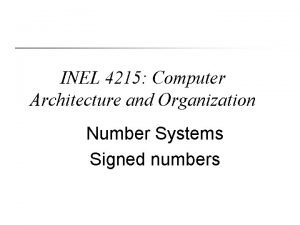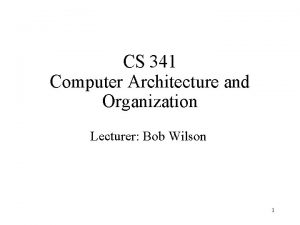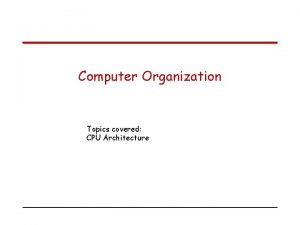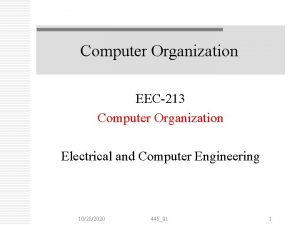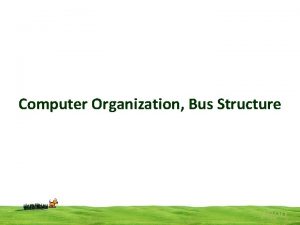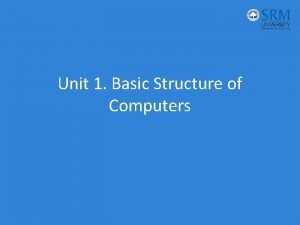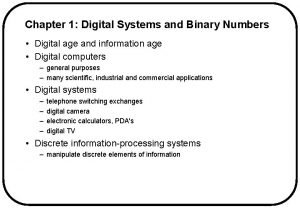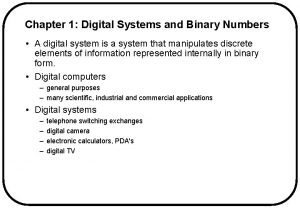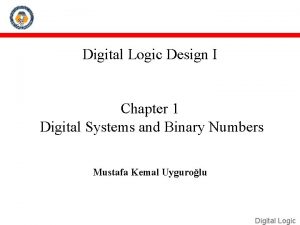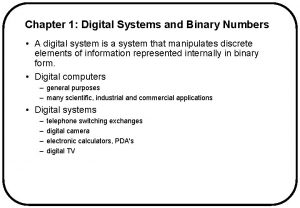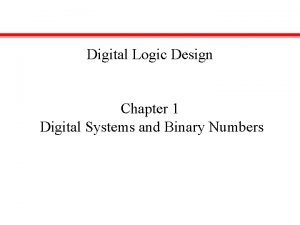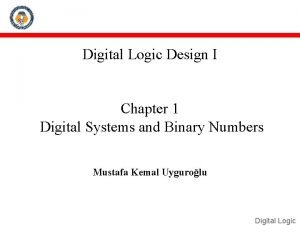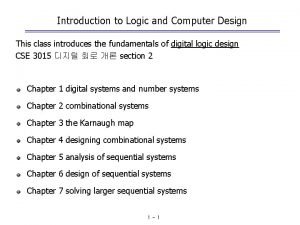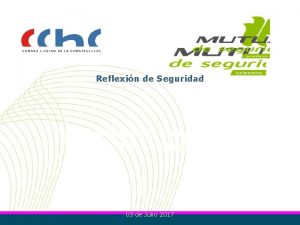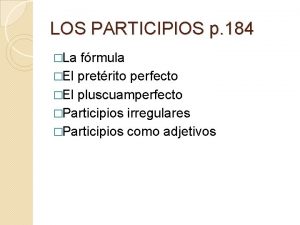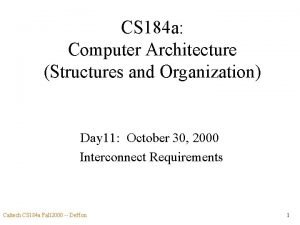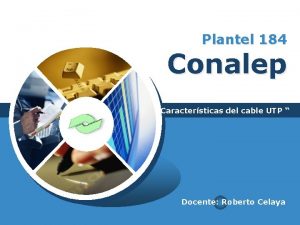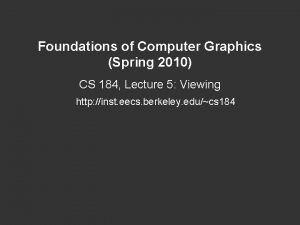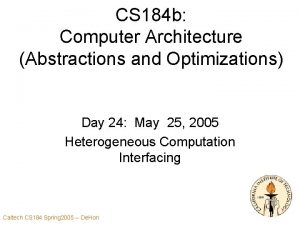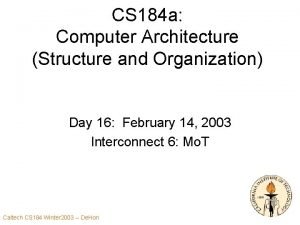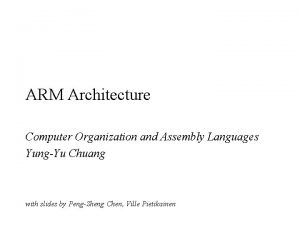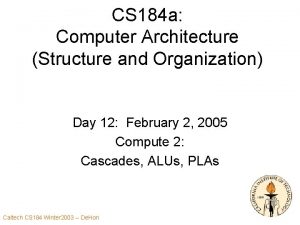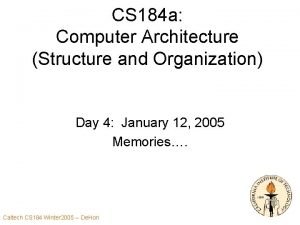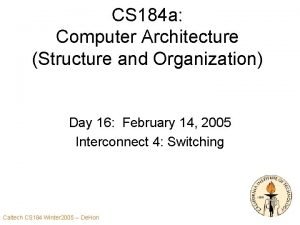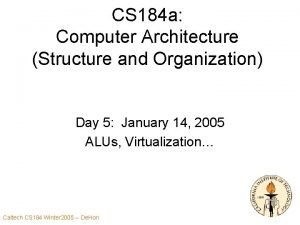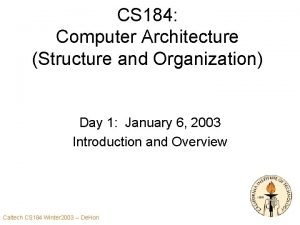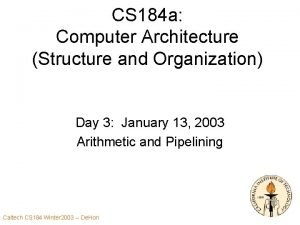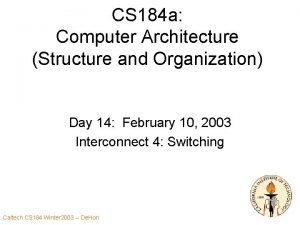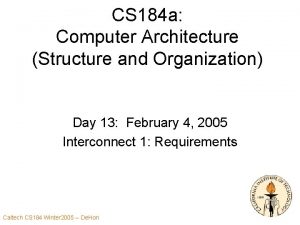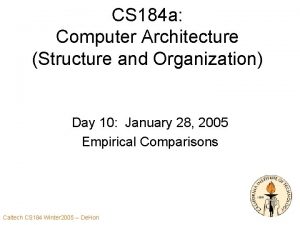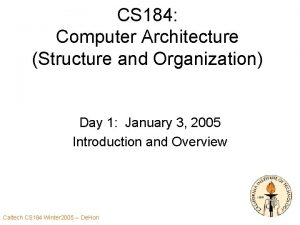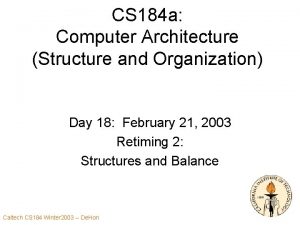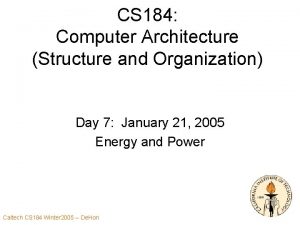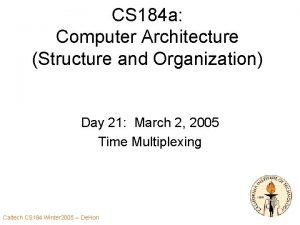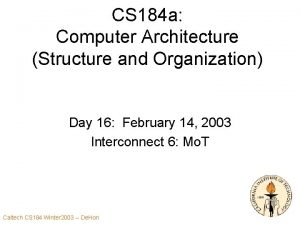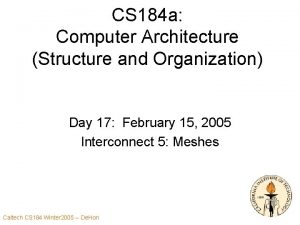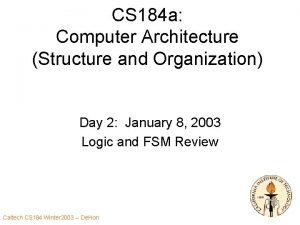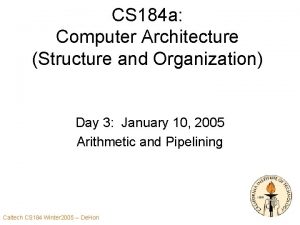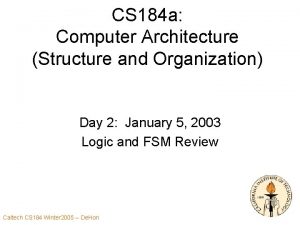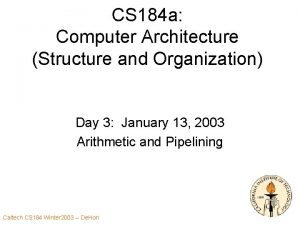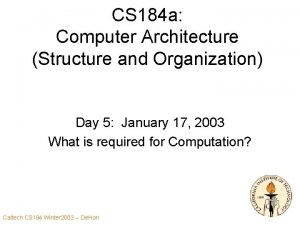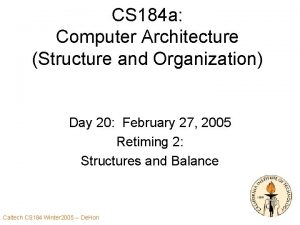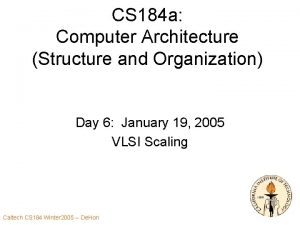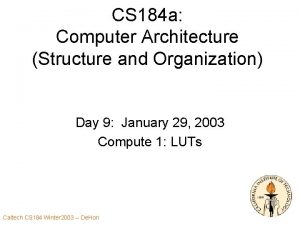CS 184 a Computer Architecture Structure and Organization










![Area Perspective [2000 tech. ] 18 mm 0. 18 mm 60 G l 2 Area Perspective [2000 tech. ] 18 mm 0. 18 mm 60 G l 2](https://slidetodoc.com/presentation_image_h/c1d000d289ee05c5b6b9e41cc804ea33/image-11.jpg)













![MOS Transistor Scaling (1974 to present) S=0. 7 [0. 5 x per 2 nodes] MOS Transistor Scaling (1974 to present) S=0. 7 [0. 5 x per 2 nodes]](https://slidetodoc.com/presentation_image_h/c1d000d289ee05c5b6b9e41cc804ea33/image-25.jpg)




![Delays? • If delays in gates/switching? – Delay reduce with 1/k [l] Caltech CS Delays? • If delays in gates/switching? – Delay reduce with 1/k [l] Caltech CS](https://slidetodoc.com/presentation_image_h/c1d000d289ee05c5b6b9e41cc804ea33/image-30.jpg)
















![Big Ideas [MSB Ideas] • Moderately predictable VLSI Scaling – unprecedented capacities/capability growth for Big Ideas [MSB Ideas] • Moderately predictable VLSI Scaling – unprecedented capacities/capability growth for](https://slidetodoc.com/presentation_image_h/c1d000d289ee05c5b6b9e41cc804ea33/image-47.jpg)
![Big Ideas [MSB-1 Ideas] • Uniform scaling reasonably accurate for past couple of decades Big Ideas [MSB-1 Ideas] • Uniform scaling reasonably accurate for past couple of decades](https://slidetodoc.com/presentation_image_h/c1d000d289ee05c5b6b9e41cc804ea33/image-48.jpg)
- Slides: 48

CS 184 a: Computer Architecture (Structure and Organization) Day 6: January 22, 2003 VLSI Scaling Caltech CS 184 Winter 2003 -- De. Hon 1

Today • • • VLSI Scaling Rules Effects Historical/predicted scaling Variations (cheating) Limits Caltech CS 184 Winter 2003 -- De. Hon 2

Why Care? • In this game, we must be able to predict the future • Rapid technology advance • Reason about changes and trends • re-evaluate prior solutions given technology at time X. Caltech CS 184 Winter 2003 -- De. Hon 3

Why Care • Cannot compare against what competitor does today – but what they can do at time you can ship • Careful not to fall off curve – lose out to someone who can stay on curve Caltech CS 184 Winter 2003 -- De. Hon 4

Scaling • Premise: features scale “uniformly” – everything gets better in a predictable manner • Parameters: § l (lambda) -- Mead and Conway (class) § S -- Bohr § 1/k -- Dennard Caltech CS 184 Winter 2003 -- De. Hon 5

Feature Size l is half the minimum feature size in a VLSI process [minimum feature usually channel width] Caltech CS 184 Winter 2003 -- De. Hon 6

Scaling • • • Channel Length (L) Channel Width (W) Oxide Thickness (Tox) Doping (Na) Voltage (V) Caltech CS 184 Winter 2003 -- De. Hon 7

Scaling • • • Channel Length (L) l Channel Width (W) l Oxide Thickness (Tox) l Doping (Na) 1/l Voltage (V) l Caltech CS 184 Winter 2003 -- De. Hon 8

Effects? • • Area Capacitance Resistance Threshold (Vth) Current (Id) Gate Delay (tgd) Wire Delay (twire) Power Caltech CS 184 Winter 2003 -- De. Hon 9

Area § l l/k § A = L * W § A A/k 2 Caltech CS 184 Winter 2003 -- De. Hon § 0. 35 mm 0. 25 mm § 50% area § 2 x capacity same area 10
![Area Perspective 2000 tech 18 mm 0 18 mm 60 G l 2 Area Perspective [2000 tech. ] 18 mm 0. 18 mm 60 G l 2](https://slidetodoc.com/presentation_image_h/c1d000d289ee05c5b6b9e41cc804ea33/image-11.jpg)
Area Perspective [2000 tech. ] 18 mm 0. 18 mm 60 G l 2 Caltech CS 184 Winter 2003 -- De. Hon 11

Capacity Scaling from Intel Caltech CS 184 Winter 2003 -- De. Hon 12

Capacitance • Capacitance per unit area – Cox= e. Si. O 2/Tox – Tox/k – Cox k Cox Caltech CS 184 Winter 2003 -- De. Hon 13

Capacitance • Gate Capacitance § Cgate= A*Cox § A A/k 2 § Cox k Cox § Cgate /k Caltech CS 184 Winter 2003 -- De. Hon 14

Threshold Voltage Caltech CS 184 Winter 2003 -- De. Hon 15

Threshold Voltage • VTH /k Caltech CS 184 Winter 2003 -- De. Hon 16

Current • Saturation Current – Id=(m. COX/2)(W/L)(Vgs-VTH)2 – Vgs=V V /k – VTH /k – W W/k – Cox k Cox – Id Id/k Caltech CS 184 Winter 2003 -- De. Hon 17

Gate Delay § tgd=Q/I=(CV)/I § V V /k § Id Id/k § C C /k § tgd /k Caltech CS 184 Winter 2003 -- De. Hon 18

Resistance • R=r. L/(W*t) • W W/k • L, t similar • R k R Caltech CS 184 Winter 2003 -- De. Hon 19

Wire Delay § twire=R C § R -> k R § C -> C /k § twire -> twire Caltech CS 184 Winter 2003 -- De. Hon • …assuming (logical) wire lengths remain constant. . . • Assume short wire or buffered wire • (unbuffered wire ultimately scales as length squared) 20

Power Dissipation (Static) • Resistive Power – P=V*I – V V /k – Id Id/k – P P /k 2 Caltech CS 184 Winter 2003 -- De. Hon 21

Power Dissipation (Dynamic) • Capacitive (Dis)charging § P=(1/2)CV 2 f § V V /k § C C /k • Increase Frequency? § f kf ? § P P/k 2 § P P/k 3 Caltech CS 184 Winter 2003 -- De. Hon 22

Effects? • • Area 1/k 2 Capacitance 1/k Resistance k Threshold (Vth) 1/k Current (Id) 1/k Gate Delay (tgd) 1/k Wire Delay (twire) 1 Power 1/k 2 1/k 3 Caltech CS 184 Winter 2003 -- De. Hon 23

ITRS Roadmap • Semiconductor Industry rides this scaling curve • Try to predict where industry going – (requirements…self fulfilling prophecy) • http: //public. itrs. net Caltech CS 184 Winter 2003 -- De. Hon 24
![MOS Transistor Scaling 1974 to present S0 7 0 5 x per 2 nodes MOS Transistor Scaling (1974 to present) S=0. 7 [0. 5 x per 2 nodes]](https://slidetodoc.com/presentation_image_h/c1d000d289ee05c5b6b9e41cc804ea33/image-25.jpg)
MOS Transistor Scaling (1974 to present) S=0. 7 [0. 5 x per 2 nodes] Pitch Source: 2001 ITRS - Exec. Summary, ORTC Figure Caltech CS 184 Winter 2003 -- De. Hon Gate [from Andrew Kahng] 25

Half Pitch (= Pitch/2) Definition Metal Pitch (Typical DRAM) Source: 2001 ITRS - Exec. Summary, ORTC Figure Caltech CS 184 Winter 2003 -- De. Hon Poly Pitch (Typical MPU/ASIC) [from Andrew Kahng] 26

Node Cycle Time: 0. 7 x Log Half-Pitch Scaling Calculator + 1994 NTRS. 7 x/3 yrs Actual -. 7 x/2 yrs Linear Time 250 -> 180 -> 130 -> 90 -> 65 -> 45 -> 32 -> 22 -> 16 0. 5 x N N+1 Node Cycle Time (T yrs): N+2 *CARR(T) = [(0. 5)^(1/2 T yrs)] - 1 * CARR(T) = Compound Annual Reduction Rate (@ cycle time period, T) Source: 2001 ITRS - Exec. Summary, ORTC Figure Caltech CS 184 Winter 2003 -- De. Hon CARR(3 yrs) = -10. 9% CARR(2 yrs) = -15. 9% [from Andrew Kahng] 27

Source: 2001 ITRS - Exec. Summary, ORTC Figure Caltech CS 184 Winter 2003 -- De. Hon [from Andrew Kahng] 28

Delays? • If delays in gates/switching? • If delays in interconnect? • Logical interconnect lengths? Caltech CS 184 Winter 2003 -- De. Hon 29
![Delays If delays in gatesswitching Delay reduce with 1k l Caltech CS Delays? • If delays in gates/switching? – Delay reduce with 1/k [l] Caltech CS](https://slidetodoc.com/presentation_image_h/c1d000d289ee05c5b6b9e41cc804ea33/image-30.jpg)
Delays? • If delays in gates/switching? – Delay reduce with 1/k [l] Caltech CS 184 Winter 2003 -- De. Hon 30

Delays • Logical capacities growing • Wirelengths? – No locallity k – Rent’s Rule • L n(p-0. 5) • [p>0. 5] Caltech CS 184 Winter 2003 -- De. Hon (slower!) 31

Compute Density • • Density = compute / (Area * Time) k 3>compute density scaling>k k 3: gates dominate, p<0. 5 k 2: moderate p, good fraction of gate delay – [p from Rent’s Rule again – more on Day 12] • k : large p (wires dominate area and delay) Caltech CS 184 Winter 2003 -- De. Hon 32

Power Density • P-> P /k 2 (static, or increase frequency) • P-> P/k 3 (dynamic, same freq. ) • A -> A/k 2 • P/A … or … P/k. A Caltech CS 184 Winter 2003 -- De. Hon 33

Cheating… • Don’t like some of the implications – High resistance wires – Higher capacitance – Need for more wiring – Not scale speed fast enough Caltech CS 184 Winter 2003 -- De. Hon 34

Improving Resistance • • R=r. L/(W*t) W W/k L, t similar R k R §Don’t scale t quite as fast. §Decrease r (copper) Caltech CS 184 Winter 2003 -- De. Hon 35

Improving Capacitance • Capacitance per unit area – Cox= e. Si. O 2/Tox – Tox/k – Cox k Cox Reduce Dielectric Constant e Caltech CS 184 Winter 2003 -- De. Hon 36

Wire Layers = More Wiring Caltech CS 184 Winter 2003 -- De. Hon 37

Typical chip cross-section illustrating hierarchical scaling methodology Wire Global (up to 5) Intermediate (up to 4) Local (2) Caltech CS 184 Winter 2003 -- De. Hon Via Passivation Dielectric Etch Stop Layer Dielectric Capping Layer Copper Conductor with Barrier/Nucleation Layer Pre Metal Dielectric Tungsten Contact Plug [from Andrew Kahng] 38

Improving Gate Delay § tgd=Q/I=(CV)/I § V V /k § Id=(m. COX/2)(W/L)(Vgs-VTH)2 § Id Id/k § C C /k § tgd /k §Lower C. §Don’t scale V. Caltech CS 184 Winter 2003 -- De. Hon Don’t scale V: V V I k. I tgd /k 2 39

…But Power Dissipation (Dynamic) • Capacitive (Dis)charging § P=(1/2)CV 2 f § V V /k § C C /k § P P/k 3 • Increase Frequency? § f kf ? § P P/k 2 If not scale V, power dissipation not scale. Caltech CS 184 Winter 2003 -- De. Hon 40

…And Power Density • P P (increase frequency) • P > P/k (dynamic, same freq. ) • A A/k 2 • P/A k. P/A … or … k 2 P/A • Power Density Increases Caltech CS 184 Winter 2003 -- De. Hon 41

Physical Limits • Doping? • Features? Caltech CS 184 Winter 2003 -- De. Hon 42

Physical Limits • Depended on – bulk effects • doping • current (many electrons) • mean free path in conductor – localized to conductors • Eventually – single electrons, atoms – distances close enough to allow tunneling Caltech CS 184 Winter 2003 -- De. Hon 43

What Is A “Red Brick” ? • Red Brick = ITRS Technology Requirement with no known solution • Alternate definition: Red Brick = something that REQUIRES billions of dollars in R&D investment Caltech CS 184 Winter 2003 -- De. Hon [from Andrew Kahng] 44

The “Red Brick Wall” - 2001 ITRS vs 1999 Source: Semiconductor International - http: //www. e-insite. net/semiconductor/index. asp? layout =article&article. Id=CA 187876 Caltech CS 184 Winter 2003 -- De. Hon [from Andrew Kahng] 45

Finishing Up. . . Caltech CS 184 Winter 2003 -- De. Hon 46
![Big Ideas MSB Ideas Moderately predictable VLSI Scaling unprecedented capacitiescapability growth for Big Ideas [MSB Ideas] • Moderately predictable VLSI Scaling – unprecedented capacities/capability growth for](https://slidetodoc.com/presentation_image_h/c1d000d289ee05c5b6b9e41cc804ea33/image-47.jpg)
Big Ideas [MSB Ideas] • Moderately predictable VLSI Scaling – unprecedented capacities/capability growth for engineered systems – change – be prepared to exploit – account for in comparing across time Caltech CS 184 Winter 2003 -- De. Hon 47
![Big Ideas MSB1 Ideas Uniform scaling reasonably accurate for past couple of decades Big Ideas [MSB-1 Ideas] • Uniform scaling reasonably accurate for past couple of decades](https://slidetodoc.com/presentation_image_h/c1d000d289ee05c5b6b9e41cc804ea33/image-48.jpg)
Big Ideas [MSB-1 Ideas] • Uniform scaling reasonably accurate for past couple of decades • Area increase k 2 – Real capacity maybe a little less? • Gate delay decreases (1/k) • Wire delay not decrease, maybe increase • Overall delay decrease less than (1/k) Caltech CS 184 Winter 2003 -- De. Hon 48
 Diff between computer organization and architecture
Diff between computer organization and architecture Basic structure of computer in computer organization
Basic structure of computer in computer organization Computer organization and architecture 10th solution
Computer organization and architecture 10th solution Vlab iit kharagpur
Vlab iit kharagpur Introduction to computer organization and architecture
Introduction to computer organization and architecture Computer organization & architecture: themes and variations
Computer organization & architecture: themes and variations Computer organization and architecture 10th edition
Computer organization and architecture 10th edition Computer organization and architecture stallings
Computer organization and architecture stallings Computer organization and architecture definition
Computer organization and architecture definition One's complement
One's complement Computer architecture and organization
Computer architecture and organization Process organization in computer organization
Process organization in computer organization Bus architecture in computer architecture
Bus architecture in computer architecture Instruction set architecture in computer organization
Instruction set architecture in computer organization Memory organisation in computer architecture
Memory organisation in computer architecture Design of basic computer
Design of basic computer Register in computer organization
Register in computer organization Single bus structure in computer organization
Single bus structure in computer organization Single bus structure in computer organization
Single bus structure in computer organization Multiple bus organization
Multiple bus organization Basic structure of computers in computer organization
Basic structure of computers in computer organization Bcd addition of 184 and 576
Bcd addition of 184 and 576 Rh nomenclature
Rh nomenclature Binary code example
Binary code example Bcd addition of 184 and 576
Bcd addition of 184 and 576 Bcd addition of 184 and 576
Bcd addition of 184 and 576 Bcd addition of 184 and 576
Bcd addition of 184 and 576 Binary hexadecimal octal decimal table
Binary hexadecimal octal decimal table Bcd addition of 184 and 576
Bcd addition of 184 and 576 Point by point compare and contrast
Point by point compare and contrast Art.184
Art.184 P 184
P 184 Signing naturally 4.1 minidialogue 3
Signing naturally 4.1 minidialogue 3 4-b sinf
4-b sinf 4 184 joules
4 184 joules Cs 184
Cs 184 Cs 184
Cs 184 Rtca do-311
Rtca do-311 Conalep coacalco
Conalep coacalco Cs 184 berkeley
Cs 184 berkeley P 184
P 184 184 bao
184 bao Tck 184
Tck 184 Art 180 lgt
Art 180 lgt Rua diogo moreira 184
Rua diogo moreira 184 Cs 184
Cs 184 Cs 184
Cs 184 Arm in computer organization
Arm in computer organization Interrupt cycle flow chart
Interrupt cycle flow chart









